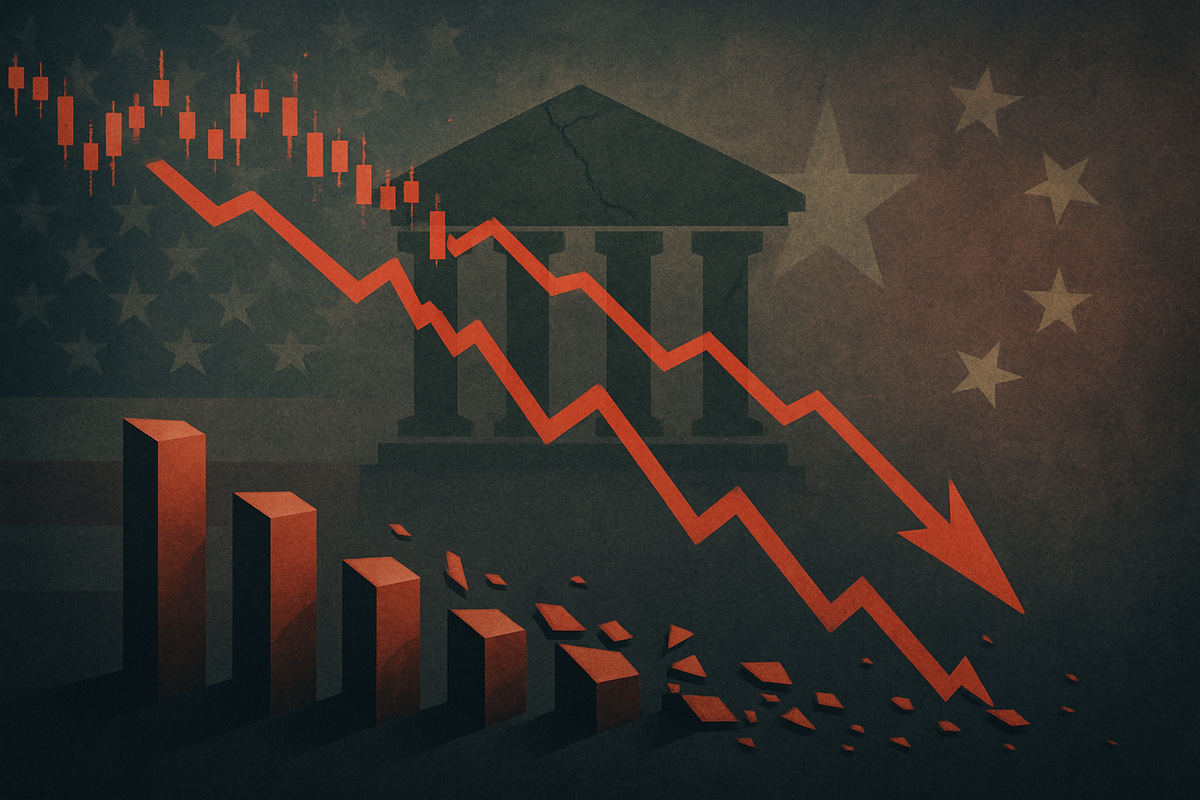
October 16, 2025 – The financial markets experienced a significant downturn today, with the Dow Jones Industrial Average plummeting 300 points, and both the S&P 500 and Nasdaq Composite indices sliding considerably. This broad-based market decline reflects a growing unease among investors, fueled by persistent concerns over the stability of regional banks and the escalating US-China trade war. The immediate implication is a surge in market volatility and a palpable shift towards investor caution, as the twin threats of domestic financial fragility and international trade tensions weigh heavily on corporate earnings outlooks and overall economic sentiment.
The sharp drop signifies increased market uncertainty, prompting a widespread "sell first and ask questions later" mentality. This has led to substantial paper losses for many investors and is expected to dampen both consumer and business confidence, potentially signaling a broader economic slowdown. As market participants grapple with these underlying economic headwinds, the focus intensifies on how these factors will continue to shape the financial landscape in the coming months.
A Day of Retreat: Dow, S&P 500, and Nasdaq Succumb to Mounting Economic Pressures
October 16, 2025, witnessed a significant retreat across major U.S. stock indices, as investor sentiment buckled under the weight of persistent regional banking anxieties and an intensifying US-China trade war. The Dow Jones Industrial Average (DJIA) notably shed 301.07 points, or 0.7%, concluding the trading day at 45,952.24. This marked a sharp reversal from earlier session gains, highlighting the pervasive uncertainty. The S&P 500 (SPX) also erased its morning advances, closing down 41.99 points, or 0.6%, at 6,629.07, while the Nasdaq Composite (IXIC) declined by 107.54 points, or 0.5%, to finish at 22,562.54. The Russell 2000 (RUT), representing smaller companies, experienced an even steeper decline, falling 52.74 points, or 2.1%, to 2,467.01, underscoring the broad impact across market capitalizations.
The market's fragility on this day was the culmination of several weeks of escalating concerns. A partial U.S. government shutdown, which began on October 1st, had already created a domestic sense of instability and obscured economic data, making it difficult for investors to accurately assess the nation's financial health. This domestic unease was severely compounded by a dramatic escalation in the US-China trade dispute. On October 10th, President Trump announced plans for a "massive" additional 100% tariff on all Chinese imports, effective November 1st, alongside new export controls targeting "any and all critical software." This announcement triggered immediate and widespread market sell-offs, with major indices tumbling significantly on that day. China swiftly retaliated by expanding its export controls on rare earth elements and related technologies, further cementing fears of a full-blown trade war. By October 14th, China had implemented a new port fee system, mirroring U.S. restrictions on Chinese-operated vessels, demonstrating the tit-for-tat nature of the conflict.
Key players at the heart of today's market slide include several regional banks. Zions Bancorporation (NASDAQ: ZION) saw its shares tumble after announcing a $50 million third-quarter charge to cover problematic loans and a $60 million provision for credit losses, citing "apparent misrepresentations and contractual defaults" by borrowers. Similarly, Western Alliance Bancorporation (NYSE: WAL) experienced a significant drop following its disclosure of a lawsuit alleging fraud against a borrower. These incidents fueled broader concerns about the credit quality within the regional banking sector, particularly regarding exposure to commercial real estate (CRE) loans amidst elevated interest rates. The U.S. government's ongoing shutdown and trade policies, alongside China's retaliatory measures, were also central to the market's volatility. Despite the overall downturn, some technology firms like TSMC (NYSE: TSM), Nvidia (NASDAQ: NVDA), and Salesforce (NYSE: CRM) reported strong earnings and guidance, providing a counterweight to the broader market's decline, especially in the tech sector.
Initial market reactions on October 16th were characterized by a pronounced flight to safety. Gold prices soared to new record highs, climbing 2.7% to $4,316, while the 10-year Treasury yield fell below 4%, reaching its lowest level since April. The regional banking sector bore the brunt of the selling pressure, with the SPDR S&P Regional Bank ETF (NYSE: KRE) plummeting 6%, marking its steepest single-day decline since April 10th. This widespread sell-off in regional banking stocks reflected a "sell first and ask questions later" mentality, as investors grappled with the implications of rising loan loss provisions and fraud allegations. The escalating trade war further compounded this negative sentiment, directly impacting risk appetite and driving investors away from equities. The combination of domestic financial concerns and international trade hostilities created a potent cocktail for market instability, leading to today's broad-based decline.
Corporate Fortunes Divided: Winners and Losers Emerge Amidst Economic Headwinds
The market's sharp decline on October 16, 2025, has created a clear delineation between potential winners and losers in the corporate landscape, heavily influenced by their exposure to regional bank vulnerabilities and the escalating US-China trade conflict. Corporate earnings across the board are expected to face significant downward pressure, as softened demand, curtailed sales revenue, and eroded profit margins become prevalent. Investor sentiment, already fragile, is shifting further towards caution and risk aversion, with panic selling becoming a notable feature of the market.
Companies most likely to bear the brunt of this downturn are regional banks with substantial exposure to commercial real estate (CRE) loans. The ongoing decline in property valuations and rising delinquency rates, particularly in the office sector, directly impact their profitability through increased loan loss provisions. We've already seen the immediate effects on Zions Bancorp (NASDAQ: ZION) and Western Alliance Bancorp (NYSE: WAL), both of which experienced significant stock plunges today due to credit quality concerns and loan charge-offs. Other regional banks with concentrated CRE portfolios, such as Fifth Third Bancorp (NASDAQ: FITB) and Regions Financial (NYSE: RF), are facing similar pressures, leading to diminished profitability and potential liquidity constraints.
The intensifying US-China trade war poses a severe threat to consumer electronics companies and retailers deeply embedded in Chinese manufacturing or with significant sales exposure to the Chinese market. Companies like Apple (NASDAQ: AAPL), despite efforts to diversify its supply chain, remains heavily reliant on China for production, making it vulnerable to increased tariffs and production shifts. Other manufacturers of high-volume consumer goods that have not fully relocated production out of China will likely grapple with higher input costs and potentially reduced demand due to increased consumer prices. Similarly, major retailers that heavily import from China, such as Macy's (NYSE: M) and Best Buy (NYSE: BBY), could see their profit margins eroded by tariffs or reduced sales if costs are passed on to consumers. Semiconductor companies, caught in the crossfire of technology export restrictions, also face significant headwinds. Nvidia (NASDAQ: NVDA), for instance, has previously encountered limitations on exporting high-end AI chips to Chinese data centers, and any further restrictions or retaliatory measures from China on critical materials would severely impact their revenue streams tied to the region.
Conversely, a select group of companies stands to benefit from these turbulent conditions. Large, diversified banks, with their robust capital positions, are well-positioned to capitalize on the distress within the regional banking sector. They could acquire smaller, struggling regional banks at attractive valuations, expanding their market presence and customer bases. Financial giants such as JPMorgan Chase (NYSE: JPM), Bank of America (NYSE: BAC), and Wells Fargo (NYSE: WFC) are poised to lead this consolidation, potentially increasing their market share and strengthening their competitive positions. Furthermore, the strategic push for "reshoring" manufacturing, driven by government initiatives like the CHIPS Act and the desire to reduce reliance on foreign supply chains, offers a silver lining for domestic manufacturers. Intel (NASDAQ: INTC), a primary beneficiary of substantial government grants to expand U.S. semiconductor manufacturing, and Texas Instruments (NASDAQ: TXN) are well-positioned to gain from this strategic shift towards domestic production. Companies involved in industrial automation, logistics, and infrastructure, such as Prologis (NYSE: PLD), a leading owner of logistics real estate, and Rockwell Automation (NYSE: ROK), an industrial automation firm, are also likely to see increased demand as businesses invest in new or expanded domestic factories and optimize their supply chains to navigate the new trade landscape.
Wider Significance: A Confluence of Crises Threatens Global Stability
The stock market's decline on October 16, 2025, is not an isolated event but rather a potent manifestation of deep-seated economic vulnerabilities and geopolitical tensions that have been steadily accumulating. This downturn signals a major reassessment of asset valuations, eroding investor and consumer confidence, tightening credit conditions, and potentially pushing global growth below already "dim" projections by the International Monetary Fund (IMF). The convergence of a resurfacing regional banking crisis and an escalating US-China trade war creates a particularly volatile environment, threatening to unravel fragile economic recoveries and introduce systemic risks.
The regional banking sector, despite previous interventions, continues to exhibit fragilities. The market decline on this day suggests that underlying weaknesses, possibly linked to concentrated commercial real estate exposure, persistent interest rate risks, and a general erosion of confidence in smaller institutions, have intensified. A stock market downturn exacerbates these issues, potentially triggering deposit outflows, forcing tighter lending standards, and increasing pressure on banks' balance sheets. This dynamic is particularly concerning given the IMF's warnings about "fiscal vulnerabilities" and "potential financial market corrections," indicating that the market is now actively pricing in these risks. A "minor-ish credit event for financial companies," as some analysts have hinted, could quickly cascade into a broader crisis if not effectively contained.
Simultaneously, the US-China trade relationship has devolved into a determined push towards economic decoupling. With average U.S. tariffs on Chinese goods around 57.6% and China's retaliatory tariffs at 32.6%, covering a vast array of products, the "renewed 'trade war' under the second Trump administration" is already sending significant ripple effects across the global economy. The market's sharp reaction to President Trump's threat of additional 100% tariffs and China's expanded export controls on rare earth elements highlights the direct link between geopolitical tensions and market stability. This prolonged uncertainty and increased protectionism, identified by the IMF as downside risks to growth, are now actively undermining investor confidence and disrupting global supply chains, fueling inflationary pressures, and injecting substantial instability into financial markets worldwide.
The ripple effects of such a decline are far-reaching. Reduced consumer spending due to eroded wealth and confidence will impact retail, travel, and luxury goods sectors. Tighter credit conditions will make it harder and more expensive for businesses, especially small firms, to secure loans, stifling investment and expansion plans. Supply chains, already strained by trade tensions, will face further disruptions as demand declines and logistics bottlenecks emerge. Stronger, well-capitalized competitors might seize opportunities to acquire struggling firms, leading to industry consolidation. In terms of regulatory and policy implications, governments and central banks would likely respond with a combination of monetary and fiscal interventions, including potential interest rate cuts, quantitative easing, and direct financial support for struggling institutions. Historically, significant market events like the Wall Street Crash of 1929, Black Monday in 1987, the dot-com bubble burst of 2000-2002, and the 2008 Financial Crisis have all led to fundamental shifts in economic policy and regulatory reforms, such as Dodd-Frank and Basel III, aimed at enhancing financial stability and increasing transparency. This current market tremor could similarly spur further tightening of regulations and increased oversight to prevent future systemic shocks, emphasizing the interconnectedness of financial markets and the real economy.
What Comes Next: Navigating a Volatile and Uncertain Horizon
The market decline on October 16, 2025, sets the stage for a period of heightened uncertainty, with both short-term volatility and long-term structural shifts on the horizon. The interplay between regional bank vulnerabilities and the escalating US-China trade war will largely dictate the trajectory of the economy and financial markets, demanding strategic pivots from companies and careful navigation from investors.
In the short-term, immediate market volatility is almost guaranteed. While historical patterns suggest that sharp market drops can be followed by relatively quick rebounds, the systemic issues at play – fragile regional banks and an intensifying trade war – could prolong instability. Investor panic selling, a common reaction to such events, risks exacerbating the downturn. We may witness "sucker's rallies" – temporary stock price increases that ultimately give way to further declines – as the market attempts to find its footing amidst conflicting economic signals. The coming weeks will be critical for observing whether regulatory interventions can effectively contain regional banking woes and if any de-escalation in trade rhetoric emerges.
Long-term, the market's resilience will be tested. While history shows that stock markets eventually recover and reach new highs, the duration of such recoveries can vary significantly. The current environment, with its twin threats, suggests that a swift, V-shaped recovery might be less likely than a more protracted U-shaped or even L-shaped recovery in certain sectors. Companies will need to make several strategic pivots to adapt. Cost-cutting and aggressive cash flow management will become paramount, including scrutinizing expenditures, optimizing workforces, and building robust cash reserves. Customer focus and retention will be critical, requiring enhanced loyalty programs and clear communication. Crucially, the US-China trade war will accelerate efforts towards diversification of supply chains away from China, potentially benefiting other "bystander economies" and driving investment in domestic manufacturing capabilities. Strategic investments in digital transformation and innovation will also be key for long-term competitiveness.
For investors, the current landscape presents both significant challenges and emerging opportunities. The regional bank woes pose a clear challenge, with continued susceptibility to credit contraction, increased loan loss provisions, and diminished profitability. Investors in regional bank stocks face heightened risk. However, for distressed asset investors and private credit funds, opportunities may arise to acquire properties or non-performing loans from struggling banks at a discount. Furthermore, larger, well-capitalized banks like JPMorgan Chase (NYSE: JPM) or Bank of America (NYSE: BAC) could benefit from market consolidation, acquiring smaller, struggling institutions. The US-China trade war presents its own set of challenges, leading to global trade flow uncertainty, reduced CAPEX spending, and higher costs for consumers and businesses. This could lead to reduced aggregate real income and slower global GDP growth. Conversely, "bystander economies" such as France, Spain, the Philippines, South Africa, Malaysia, and Taiwan could see increased exports to the U.S. as Chinese goods become less competitive, offering new investment avenues.
Considering these factors, several potential scenarios and outcomes emerge. A Controlled Correction and Resilient Recovery (moderately optimistic) could see the market stabilize within 1-2 years, assuming regional bank issues are contained by regulatory action and trade tensions avoid further drastic escalation. In this scenario, companies that quickly pivot to cost control and supply chain adjustments would emerge stronger. A more Prolonged Downturn with Recessionary Pressures (moderately pessimistic) could occur if regional bank woes intensify into a widespread credit crunch and the trade war escalates further, leading to a recession and a market recovery lasting several years. The most Pessimistic Scenario is Stagflation, where trade war tariffs lead to persistent inflation, while banking instability stifles economic growth. This combination of high inflation and low growth would create a challenging environment for both companies and investors, potentially requiring the Federal Reserve to maintain higher interest rates, further dampening economic activity. Investors should prioritize diversification, focus on resilient sectors, and maintain liquidity to navigate these uncertain times.
Wrap-Up: A Call for Caution and Strategic Adaptation in a Shifting Market
The stock market's notable decline on October 16, 2025, serves as a stark reminder of the interconnectedness of global finance and geopolitics. The key takeaways from this turbulent day underscore a confluence of persistent challenges: heightened credit concerns emanating from the regional banking sector, and the escalating US-China trade war creating significant geopolitical and economic uncertainty. This dual threat has triggered increased market volatility and a palpable shift towards risk aversion among investors, impacting corporate profitability and overall economic sentiment.
Moving forward, the market is likely to remain characterized by elevated volatility and acute sensitivity to economic and geopolitical headlines. The lasting impact of regional bank woes will manifest in continued scrutiny of loan portfolios, particularly commercial real estate exposure, and potentially lead to restricted lending practices that could dampen economic activity for small and medium-sized businesses. This environment may also accelerate consolidation within the banking sector, favoring larger, more robust financial institutions. The lasting impact of the US-China trade war will likely include an accelerated drive towards supply chain decoupling, leading to higher costs and inflationary pressures for consumers and businesses, and reduced corporate profitability for firms heavily exposed to bilateral trade. Markets will also continue to price in a persistent "geopolitical risk premium," ensuring that any new developments in US-China relations trigger further volatility.
In the coming months, investors should remain exceptionally vigilant. Key areas to watch include:
- Developments in the Regional Banking Sector: Closely monitor earnings reports and disclosures from regional banks for any further signs of loan losses, increased provisions for credit losses, or fraud allegations. Pay attention to regulatory responses aimed at stabilizing the sector and the overall health of the commercial real estate market.
- US-China Trade and Geopolitical Relations: Keep a close eye on any new announcements regarding tariffs, export controls (especially on critical materials or semiconductors), or changes in trade policy from either the U.S. or China. Any high-level meetings or their cancellations could signal shifts in diplomatic efforts.
- Broader Economic Indicators: Scrutinize inflation figures, labor market reports, and consumer spending trends as they become available, as these will provide crucial insights into central bank monetary policy decisions and the underlying health of the economy. The VIX index will remain a critical gauge of market fear and volatility.
In such an environment, prudent investment strategies emphasize diversification across various asset classes, sectors, and geographies. Maintaining a long-term perspective and avoiding rash decisions based on short-term fluctuations is crucial. Investors should prioritize quality investments in companies with strong balance sheets, solid fundamentals, and proven management teams capable of navigating economic headwinds. Building cash reserves or investing in safe-haven assets like gold can offer some protection during volatile periods. Dollar-cost averaging for ongoing investments can help mitigate the impact of market swings. Staying informed and adaptable will be paramount for successfully navigating the challenging and evolving market landscape ahead.
This content is intended for informational purposes only and is not financial advice





